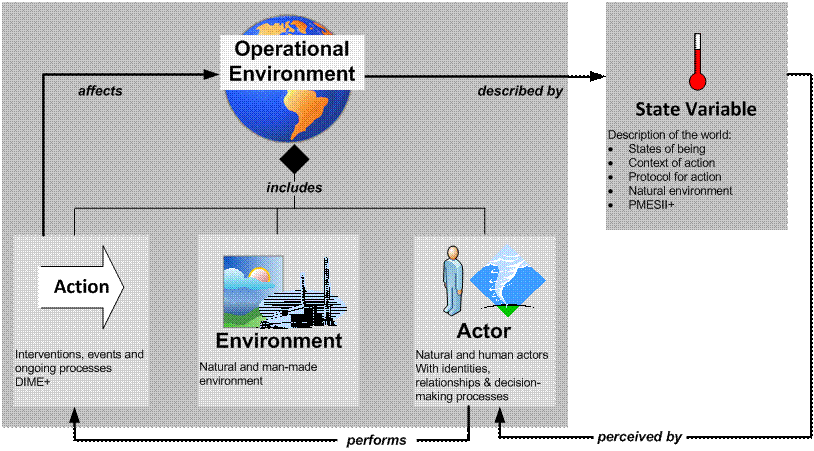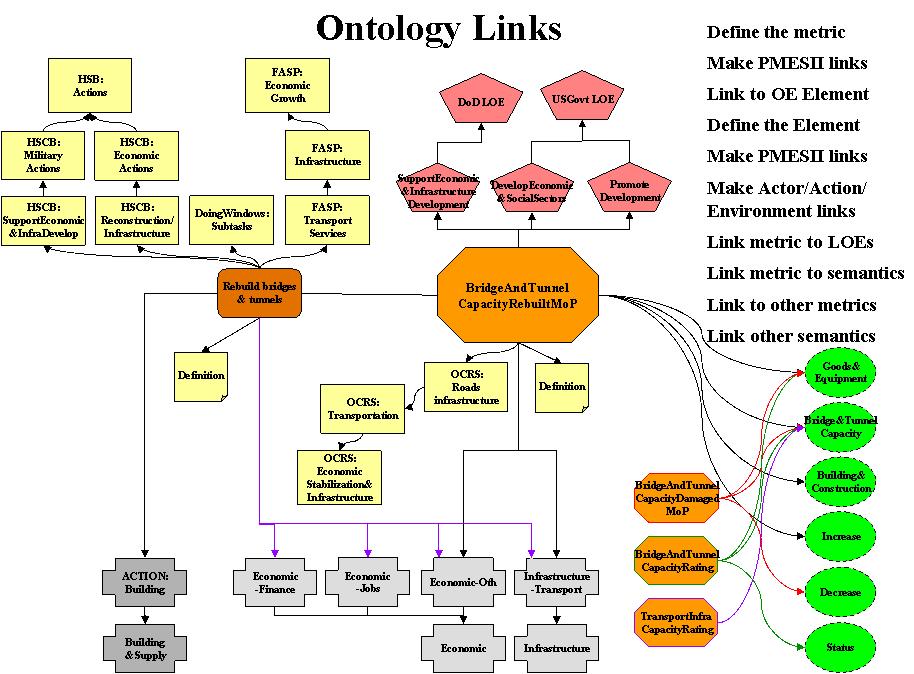Create a total ontology of the elements needed for modeling Irregular Warfare (IW).
The IW Metric Ontology project developed the ontology for
the metrics; however, it only identified the precursor elements, Actions,
Environment, and Actors, without developing ontologies for them.
The process of creating a total IW ontology consisted of five tasks: element
identification, ontology structures development, completeness checking, semantic coding,
and extended LOE connection. In practice, these tasks were not completely separable, as new
elements might require additions to the structures; the completeness tests might
imply the needs for new elements; the structures themselves might suggest the
need for new elements through completeness arguments; and semantic coding had to
be done for new elements, which might suggest new semantic codes, relevant to
old elements.
Identifying Elements:
Thirteen sources were used in identifying elements. The first three
were used to create the initial set and the remaining eight were connected to
the initial eight, where possible, and used to generate additional elements
where there were no matches. The additional sources were also used in
refining the names and definitions of the elements, broadening their meanings
where appropriate. This process ensured that multiple points of view were
considered to maximize the coverage by the set of elements.
1. Doing Windows Network
|
The Doing Windows Taxonomy is described
in the diagram to the right. The variables are contained in
the four influence nets. In addition the taxonomy is linked to
a table of citations (reproduced toward the end of this page) - here
"DoingWindows." The contents of the network are given in
rptDoingWindowsNetwork.pdf. |
 |
2. ISSM Network
|
The Interim Semi-static Stability Model (ISSM) Taxonomy is described
in the diagram to the right. There are three levels to the
taxonomy, each containing the influence variables. In addition
the taxonomy is linked to a table of citations (reproduced toward
the end of this page) - here "ISSM AG." The contents
of the network are given in rptISSMNetwork.pdf. |
 |
3. VV&A Tool Ontology
|
The DIME/PMESII VV&A Tool Ontology is described
in the diagram to the right. There are three
levels to the ontology, with the variables connected to the lowest
level shown in the diagram. DIME variables are connected both
to the Status box and to the DIME box.
In addition the ontology is linked to a table of citations
(reproduced toward the end of this page) - here "VV&A Tool."
The contents of the ontology are given in
rptVVAToolOntology.pdf. |
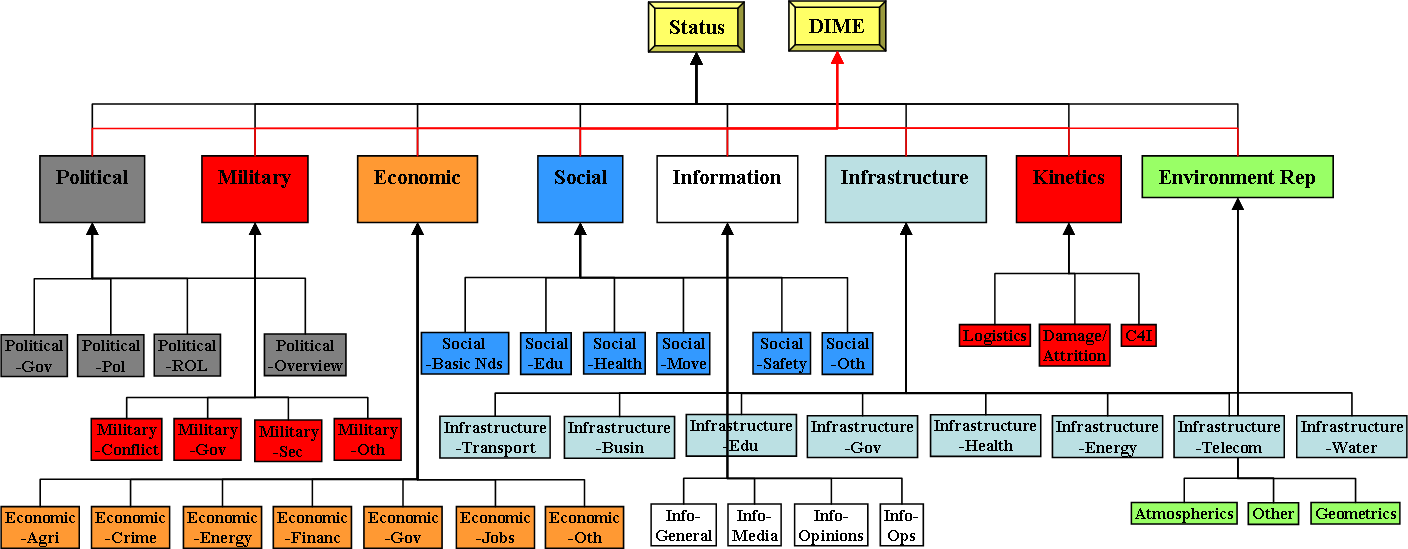 |
4. Haskins List
|
The Haskins List is described in the relational
database design to the right. There is only one level to the
list, with a text description (Haskins). In addition the taxonomy is linked to a table
of citations (reproduced toward the end of this page) - here
"Haskins." The contents of the ontology are given in
rptHaskinsList.pdf. |
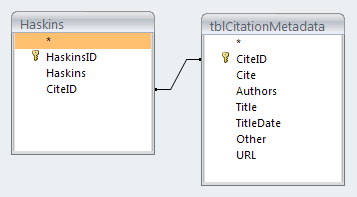 |
5. OCRS Taxonomy
|
The Office of the Coordinator for Reconstruction and Stabilization
(OCRS) Essential Tasks Taxonomy is described in the relational
database design to the right. There are three levels to the
taxonomy, each with a text description (OCRSLev1, OCRSLev2, and
OCRSMatrixItem). In addition the taxonomy is linked to a table
of citations (reproduced toward the end of this page) - here "OCRS."
The contents of the taxonomy are given in
rptOCRSTaxonomy.pdf. |
 |
6. MPICE Ontology
|
The Measuring Progress in Conflict Environments (MPICE) Ontology is described
in the diagram to the right. There are four
levels to the ontology, each with a text description (MPICECat and
MPICEAltCat at the top level, MSubCat at the second level,
MPICEdescription at the third level, and Metric Instance at the
bottom level). In addition the ontology is linked to a table of citations
(reproduced toward the end of this page) - here "MPICE."
The contents of the ontology are given in
rptMPICEOntology.pdf. |
 |
7. Hillson Taxonomy
|
The Hillson Taxonomy is described in the relational
database design to the right. There are three levels to the
taxonomy, each with a text description (HilsonCategory, HilsonItem and
MOFE Indicator). In addition the taxonomy is linked to a table
of citations (reproduced toward the end of this page) - here
"Hillson." The contents of the ontology are given in
rptHillsonTaxonomy.pdf. |
 |
8. Corruption Model Ontology
|
The ontology for the Corruption Model, developed from a National
Defense University (NDU) workshop, is described in the relational
database design to the right. There are two levels to the
ontology, each with a text description (CorruptionCat and
CorruptionItem). In addition the taxonomy is linked to a table
of citations (reproduced toward the end of this page) - here
"Corruption." The contents of the ontology are given in
rptCorruptionOntology.pdf. |
 |
9. IWDecomp List
|
The TRAC 2009 IW Decomposition TEO List is described in the relational
database design to the right. There is only one level to the
list, with a text description (IWDecomp2009TEOsWorkshop subject). In addition the taxonomy is linked to a table
of citations (reproduced toward the end of this page) - here
"IWDecomp." The contents of the ontology are given in
rptDecompList.pdf. |
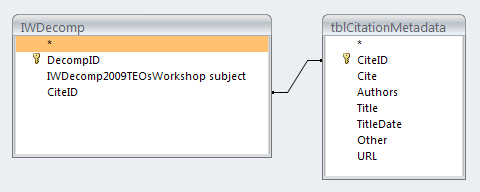 |
10. Metrics V3 Taxonomy
|
The TRAC Metrics V3 Taxonomy is described in the relational
database design to the right. There are three levels to the
taxonomy, each with a text description (MetV3Cat, MetV3SubCat and
Metrics v3). In addition the taxonomy is linked to a table
of citations (reproduced toward the end of this page) - here
"Metrics v3." The contents of the ontology are given in
rptMetricsV3Taxonomy.pdf. |
 |
11. HSCB Taxonomy
|
Mitre's Human Social Cultural Behavior (HSCB) Taxonomy is described
in the relational database design to the right. There are five
levels to the taxonomy, each with a text description (Taxon).
In addition the taxonomy is linked to a table of citations
(reproduced toward the end of this page) - here "HSCB." The
contents of the taxonomy are given in
rptHSCBTaxonomy.pdf. |
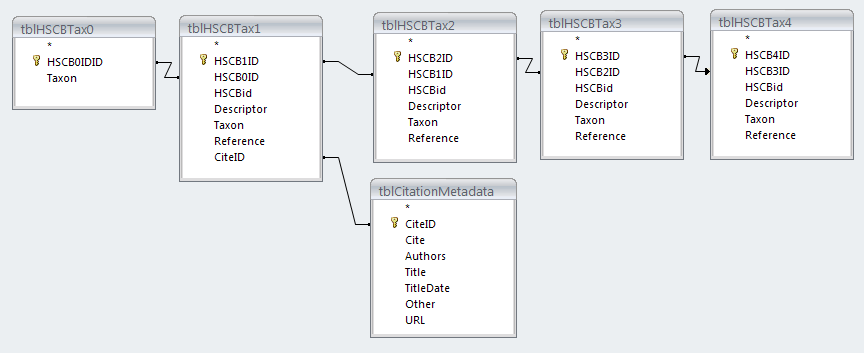 |
12. PRIME Taxonomy
|
SRI's PRIME Taxonomy is described
in the relational database design to the right. There are
three
levels to the taxonomy, each with a text description (PRIMELevel1-3).
In addition the taxonomy is linked to a table of citations
(reproduced toward the end of this page) - here "PRIME." The
contents of the taxonomy are given in
rptPRIMETaxonomy.pdf. |
 |
13. FASP Taxonomy
|
The Department of State and USAID Foreign Assistance Standardized
Program (FASP) Taxonomy is described
in the relational database design to the right. There are four
levels to the taxonomy, each with a text description (ProgramName,
ProgramArea, ProgramElement, and ProgramSubElement).
In addition the taxonomy is linked to a table of citations
(reproduced toward the end of this page) - here "FASP." The
contents of the taxonomy are given in
rptFASPTaxonomy.pdf. |
 |
Developing Ontology Structures:
The initial effort (the IW
Metric Ontology project) focused on creating a metric ontology, using the
actor, action, and environment elements as reference data. This effort
focuses on completing the actor, action, and environment ontologies, with the
possibility of creating additional metric classes in the process.
1. Metric Ontology
The figure below provides a sketch of the metric ontology. All of the
metrics are represented by a single class with an vertical arrow representing
the connection(s) of the element to the PMESII subcategories and with a
horizontal arrow representing the connection(s) to the DoD Lines of Effort (LOEs).
There are more than 600 elements in the metric ontology. These elements
are included with the categories and subcategories to which they are linked in a
report that gives extended definitions by showing the elements from the 13
sources that relate to each (
rptMetricsExtendedDef.pdf).
2. Actor Ontology
|
The figure to the right is a sketch of the actor ontology. In
this case, the PMESII representation is abbreviated to the category
level to reduce clutter. The actor categories and subcategories are
fully populated to show that taxonomy. As in the figure above, each
element is connected to one or more of the PMESII subcategories and
one or more of the Actor subcategories. There are more than 80
actor elements in the ontology. These elements are included
with the action and environment elements in a report that gives
extended definitions by showing the elements from the 13 sources
that relate to each (rptOEElementsExtendedDefs.pdf). |
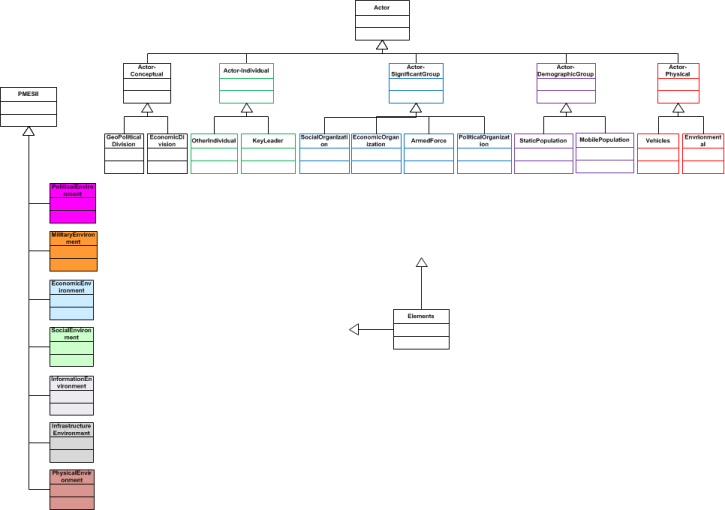 |
3. Action Ontology
|
The figure to the right is a sketch of the action ontology. The
PMESII representation is abbreviated to the category level to reduce
clutter. The action taxonomy is fully populated, but has no
subcategories. As in the figure above, each element is connected to
one or more of the PMESII subcategories and one or more of the
Action categories. There are more than 300 action elements in the
ontology. These elements are included with the action and
environment elements in a report that gives extended definitions by
showing the elements from the 13 sources that relate to each (rptOEElementsExtendedDefs.pdf). |
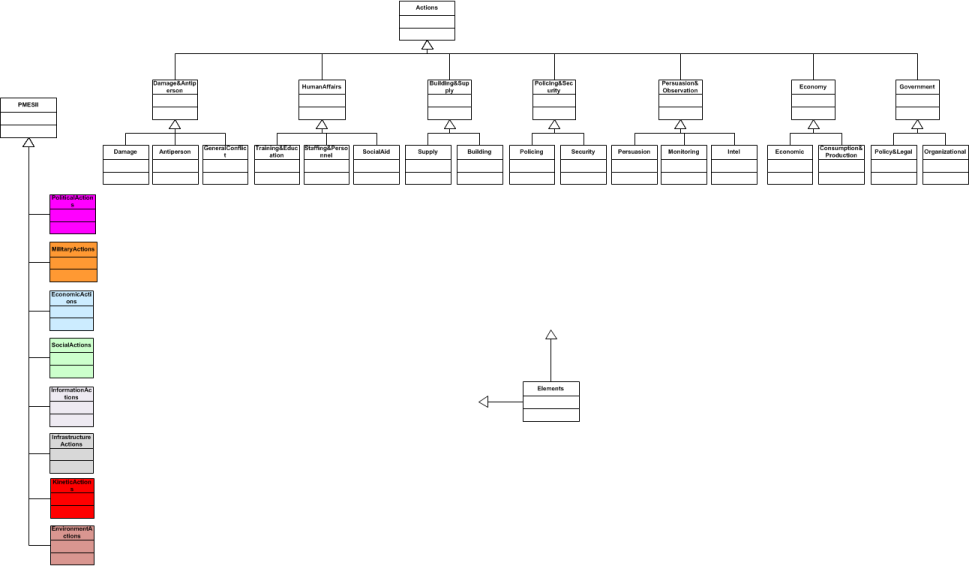 |
4. Environment Ontology
|
The figure to the right is a sketch of the environment ontology. The PMESII
representation is abbreviated to the category level to reduce clutter.
The environment categories and subcategories are fully populated to show
that taxonomy. As in the figure above, each element is connected to one
or more of the PMESII subcategories and one or more of the Environment
subcategories. There are more than 160 environment elements in the
ontology. These elements are included with the action and environment
elements in a report that gives extended definitions by showing the elements
from the 13 sources that relate to each (rptOEElementsExtendedDefs.pdf). |
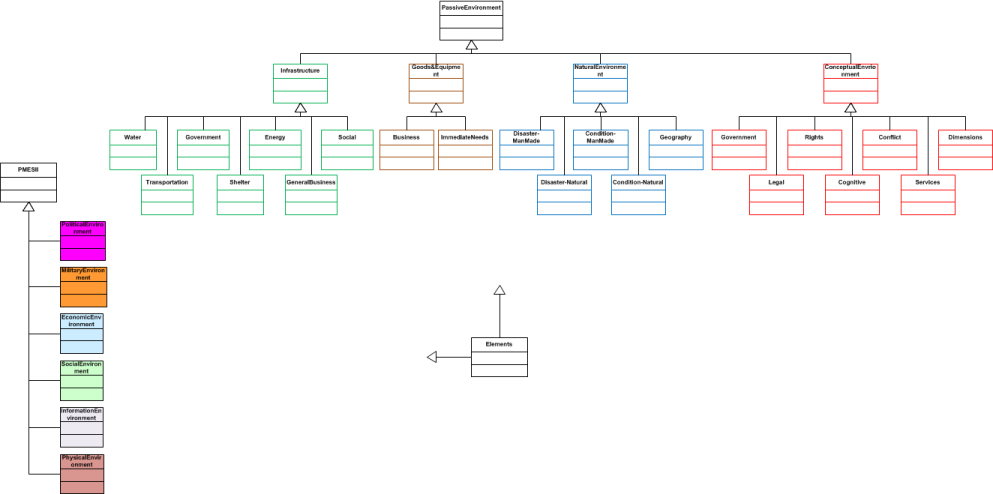 |
Defining the Elements
|
The elements of an ontology are "a controlled vocabulary" according
to the definition of ontologies. A controlled vocabulary can
be a set of terms that are identified as being special, but are not
defined. (Pure mathematics uses this technique for its
fundamental terms.) However, IW ontologies need to have
identifiable referents to the real world to be useful. The
structure of the ontologies supports this need. Each element
(three are shown in the figure to the right) has certain attributes
that help define it. In addition, the ontological structure provides
additional information that helps define the element. Further,
the links to the sources provide information about the concepts that
are meant to be included in the definition of the element.
Each element has a name that provides a very short description of
the element. This is followed by a phrase that defines the
element more formally. Finally, each element is identified as
an actor, environment, or action element (or as more than one of
these).
Each of the three elements in the figure has its PMESII category
or categories and subcategories listed with the "PMESII" cite.
For example, the third element is contained in both the Political
and the Social categories. Depending on the type of element,
it will also have its Actor, Action, or Environment structure links
identified. These three elements have single links; however,
other elements have multiple links, as in the third elements PMESII
structure.
Finally, each element displays the name of each source from which
it is derived (here PRIME, Corruption, and HSCB are cited) and the
Major, Minor, and Detail information for the particular link.
Together, these parts of the extended definition enable the user
to develop a good understanding of what is meant by the element. |
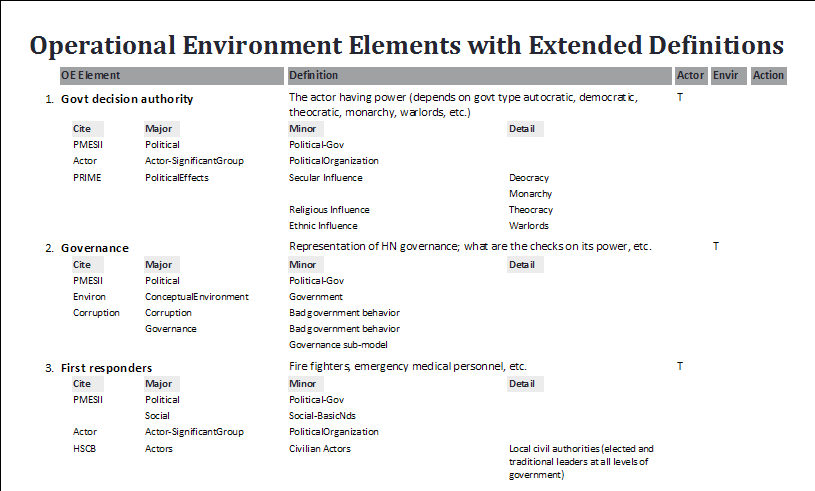 |
Checking Completeness:
Three of the completeness checking processes are fairly well-defined.
However, the fourth process is definitely more art than science.
1. Action-Object Completeness:
The action-object pairing relates to modeling objects with size or quantity
attributes that are variable. For these objects, a measure of the current
size or quantity is required and methods that change the size or quantity are
also required.
a. Each object (actor or environmental
object) may need actions to change its size or composition. This can
be particular actions such as birth and death actions for populations or
training and retirement/completion of enlistment/desertion for military
personnel or it may be simple increase and decrease actions.
b. Each action may need an object that
represents the status (both before and after the change). For example,
training new political leaders implies a change in the set of political leaders
and improving HN executive function requires a HN executive branch.
2. Actor-Action Completeness:
The actor-action pairing relates to the realization that an actor that
doesn't initiate any actions in a model is really just an environmental
attribute (in that model) and that while some actions might be considered as
spontaneously occurring, most are initiated by an actor.
a. Each action may need an actor
or actors that can initiate the action. For example, rebuilding
actions may require both local workers and businesses and external
contractors.
b. Each actor may need an action or
actions that it can initiate. For example courts conduct judicial
activities.
3. Object-Actor Completeness:
The object (environmental object or actor object)-actor pairing also has a
pair of tests; however, these approach the semantic completeness check in
regards to art versus science.
a. Some actors imply additional
objects by their nature. For example external contractors implies
a need for key external contractors.
b. Some objects imply particular actors by
their nature. For example freedom of international media to report implies
a need for international media and key international media leaders.
4. Semantic Completeness:
The semantic completeness check involves generating a
set of terms that relate to the elements through similar meanings
(semantics). Each of the elements is checked for the existence of
a relation to each term. Then the collections of elements that
relate to each term are examined to see if any elements are "missing."
(See the next section.) Any missing elements are added to the set
of elements, categorized and checked for completeness using the first
three processes.
Coding Semantics:
More than 200 semantic terms were generated by the metric
ontology classes. For convenience, these were organized into semantic
classes. The contents are given in
rptSemanticTerms.pdf. Each of the more than 600 metric ontology
classes were associated with several semantic terms, yielding more than 2600
associations, as illustrated below.
Once these associations were determined to be approximately complete, they
were reordered by the semantic terms, as shown below. This reordering
permitted an examination for semantic association completeness in this other
direction and an examination for missing metric classes.
The connection of the associated semantic terms with the metric classes (and,
through the connection between the metric ontology and the actor, action, and
environment ontologies, an association of the semantic terms with these
ontologies) permits computer programs to make semantic inferences about the
connections among ontology elements.
Extending the LOE
connections:
At the end of the IW Ontology Project, the TRAC working group created
ontologies for the other stakeholders involved in their model and generated
connections among the new LOEs and the metrics. The parties were:
- Allied Forces (using the US Department of Defense LOEs),
- Afgan Criminals,
- Afghan Government - Provincial,
- Afghan National Army - Provincial,
- Afghan National Police - Provincial,
- Afghan Taliban Groups,
- Afghan Terrorists,
- NGOs-Afghanistan, and
- US Government organizations other than DoD.
The new LOEs included both "official" LOEs (those openly admitted) and
unofficial LOEs (not openly admitted LOEs). The complete list of
official LOEs is given in
rptAllOfficialLOEsNoSubtasks.pdf. Another report (rptAllOfficialLOEs.pdf)
shows the official LOES and the subtasks for each LOE. A third report
(rptOfficialLOEsWithMetricsByLOEOwner.pdf)
shows the metrics that were assigned to each of the official LOEs.
| # |
Citation |
Authors |
Title |
Date |
Publisher |
URL |
| 1 |
DoingWindows |
Hayes, Bradd C. & Jeffrey I. Sands |
Doing Windows: Non-Traditional Military Responses to Complex Emergencies |
1998 |
CCRP, Washington, DC |
|
| 2 |
ISSM AG |
Hartley, Dean S., III |
Operations Other Than War (OOTW) Flexible Asymmetric Simulation Technologies (FAST) Prototype Toolbox: ISSM v4.00 Analysts' Guide |
2006 |
DRC, Orlando, FL |
ISSM |
| 3 |
VV&A Tool |
Hartley, Dean S., III |
DIME/PMESII VV&A Tool (Software) |
2009 |
Hartley Consulting, Oak Ridge, TN |
VVATool |
| 4 |
Haskins |
Haskins, Casey |
"A Practical Approach to Cultural Insight," Military Review |
Sept-Oct 2010 |
|
|
| 5 |
OCRS |
Office of the Coordinator for Reconstruction and Stabilization |
Post-Conflict Reconstruction Essential Tasks |
2005 |
US Dept of State, Washington, DC |
http://www.crs.state.gov/index.cfm?fuseaction=public.display&id=10234c2e-a5fc-4333-bd82-037d1d42b725 |
| 6 |
MPICE |
Dziedzic, Michael; Barbara Sotirin; and John Agoglia |
Measuring Progress in Conflict Environments (MPICE): A Metrics Framework for Assessing Conflict Transformation and Stabilization, Version 1.0 |
2008 |
US Institute for Peace, Washington, DC |
|
| 7 |
Hillson |
Hillson, Roger; et al. |
Requirements for a Government Owned DIME/PMESII Model Suite |
2009 |
Office of the Secretary of Defense Modeling & Simulation Steering Committee, Washington, DC |
|
| 8 |
Corruption |
Hartley, Dean S., III |
Corruption in Afghanistan: Conceptual Model |
21 August 2010 |
Hartley Consulting, Oak Ridge, TN |
NDUHSCB |
| 9 |
IWDecomp |
US Army TRAC |
IW Decomposition Analytic Strategy, TRAC, Overview Briefing for IW WG |
6 January 2009 |
TRAC, Ft Leavenworth, KS |
|
| 10 |
Metrics v3 |
Works, Paul |
Metrics v3.xls |
2010 |
TRAC, Ft Leavenworth, KS |
|
| 11 |
HSCB |
Klein, G. |
"A Taxonomy for HSCB Research and Operations" Proceedings of the HSCB Focus 2011 Conference |
February 8-10, 2011 |
Chantilly, VA |
listing |
| 12 |
PRIME |
Lowrance, J.D. & J. L. Murdock |
Political, Military, Economic, Social, Infrastructure, Information (PMESII) Effects Forecasting for Course of Action (COA) Evaluation |
2009 |
Air Force Research Laboratory, Rome, NY |
picture |
| 13 |
FASP |
Department of State & USAID |
Foreign Assistance Standardized Program Structure and Definitions |
10/20/2006 |
Washington, DC |
|
| 14 |
FM3-24.2 |
US Army |
FM 3-24.2 |
APR 09 |
Washington, DC |
|
| 15 |
OntWS3 |
TRAC Ontology Workshop 3 |
Non-DoD LOEs |
7/15/2011 |
TRAC, Ft Leavenworth, KS |
|
The work has been presented in several venues during and after the project, as
shown below.
If you arrived here using a keyword shortcut, you may use your
browser's "back" key to return to the keyword
distribution page.
